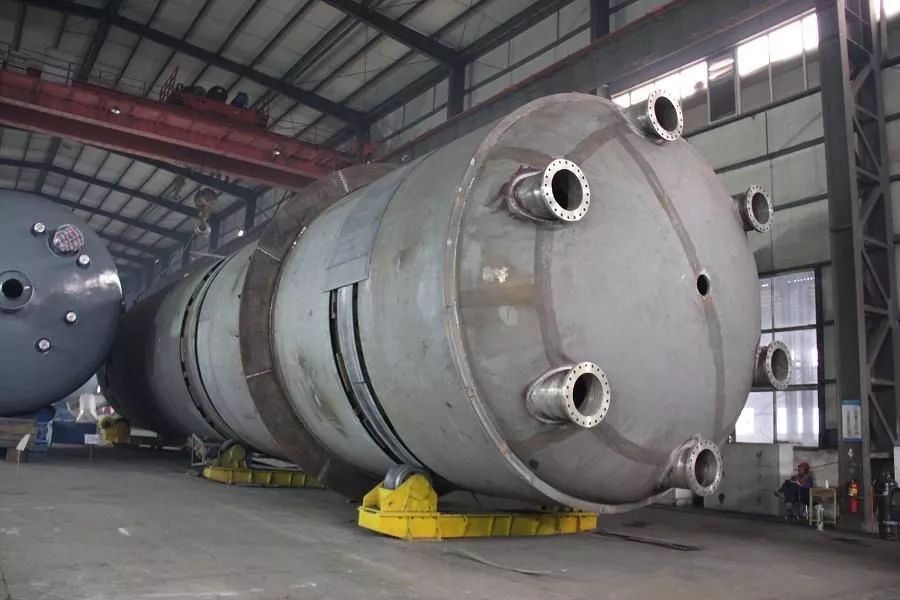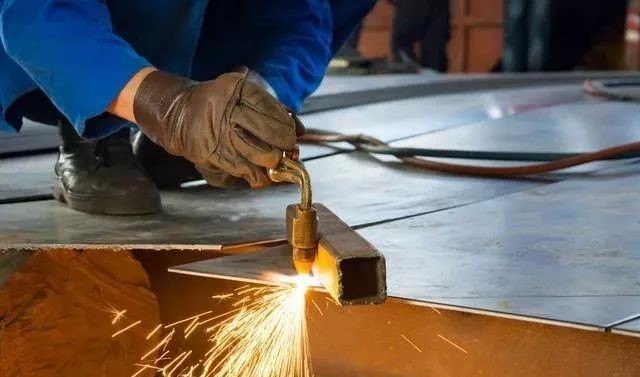In the manufacture of pressure vessels, when submerged arc welding is used to weld the longitudinal weld of the cylinder, cracks (hereinafter referred to as terminal cracks) often occur at or near the end of the longitudinal weld.
Many people have conducted research on this, and believe that the main reason for terminal cracks is that when the welding arc is close to the terminal of the longitudinal weld, the weld expands and deforms in the axial direction, and is accompanied by transverse tension in the vertical and axial direction. open deformation;
The cylinder body also has cold work hardening stress and assembly stress in the process of rolling, manufacturing and assembly; during the welding process, due to the restraint of the terminal positioning weld and the arc strike plate, a large stretch is generated at the end of the weld stress;
When the arc moves to the terminal positioning weld and the arc strike plate, due to the thermal expansion and deformation of this part, the transverse tensile stress of the weld terminal is relaxed, and the binding force is reduced, so that the weld metal just solidified at the weld terminal The terminal cracks are formed by a large tensile stress.
Based on the analysis of the above reasons, two countermeasures are proposed:
One is to increase the width of the arc strike plate to increase its binding force;
The second is to use slotted elastic restraint arc strike plate.
However, after taking the above countermeasures in practice, the problem has not been effectively solved:
For example, although the elastic restraint arc strike plate is used, the terminal cracks of the longitudinal weld will still occur, and terminal cracks often occur when welding the cylinder with small thickness, low rigidity and forced assembly;
However, when there is a product test plate in the extended part of the longitudinal weld of the cylinder, although the tack welding and other conditions are the same as when there is no product test plate, there are few terminal cracks in the longitudinal seam.
After repeated tests and analysis, it is found that the occurrence of cracks at the end of the longitudinal seam is not only related to the inevitable large tensile stress at the end weld, but also related to several other extremely important reasons.
First. Analysis of the causes of terminal cracks
1. Changes in the temperature field at the terminal weld
During arc welding, when the welding heat source is close to the end of the longitudinal weld, the normal temperature field at the end of the weld will change, and the closer it is to the end, the greater the change.
Because the size of the arc strike plate is much smaller than that of the cylinder, its heat capacity is also much smaller, and the connection between the arc strike plate and the cylinder is only by tack welding, so it can be regarded as mostly discontinuous.
Therefore, the heat transfer condition of the terminal weld is very poor, causing the local temperature to rise, the shape of the molten pool changes, and the penetration depth will also increase accordingly. The solidification speed of the molten pool slows down, especially when the size of the arc strike plate is too small, and the tack weld between the arc strike plate and the cylinder is too short and too thin.
2. Influence of welding heat input
Since the welding heat input used in submerged arc welding is often much larger than other welding methods, the penetration depth is large, the amount of deposited metal is large, and it is covered by the flux layer, so the molten pool is large and the solidification speed of the molten pool is large. The cooling rate of the welding seam and the welding seam are slower than other welding methods, resulting in coarser grains and more serious segregation, which create extremely favorable conditions for the generation of hot cracks.
In addition, the lateral shrinkage of the weld is much smaller than the opening of the gap, so that the lateral tensile force of the terminal part is larger than that of other welding methods. This is especially true for beveled medium-thick plates and non-beveled thinner plates.
3. Other situations
If there is forced assembly, the assembly quality does not meet the requirements, the content of impurities such as S and P in the base metal is too high and segregation will also lead to cracks.
Second, the nature of the terminal crack
Terminal cracks belong to thermal cracks according to their nature, and thermal cracks can be divided into crystallization cracks and sub-solid phase cracks according to the stage of their formation. Although the part where the terminal crack is formed is sometimes the terminal, sometimes it is within 150mm from the area around the terminal, sometimes it is a surface crack, and sometimes it is an internal crack, and most of the cases are internal cracks that occur around the terminal.
It can be seen that the nature of the terminal crack basically belongs to the sub-solid phase crack, that is, when the weld terminal is still in a liquid state, although the molten pool near the terminal has solidified, it is still at a high temperature slightly below the solidus line Zero-strength state, cracks are generated under the action of complex welding stress (mainly tensile stress) at the terminal,
The surface layer of the weld near the surface is easy to dissipate heat, the temperature is relatively low, and it already has a certain strength and excellent plasticity, so the terminal cracks often exist inside the weld and cannot be found with the naked eye.
Third. Measures to prevent terminal cracks
From the above analysis of the causes of terminal cracks, it can be seen that the most important measures to overcome the terminal cracks of submerged arc welding longitudinal seams are:
1. Appropriately increase the size of the arc strike plate
People are often not familiar enough with the importance of the arc strike plate, thinking that the function of the arc strike plate is only to lead the arc crater out of the weldment when the arc is closed. In order to save steel, some arc strikers are made very small and become veritable “arc strikers”. These practices are very wrong. The arc strike plate has four functions:
(1) Lead the broken part of the weld when the arc is started and the arc crater when the arc is stopped to the outside of the weldment.
(2) Strengthen the degree of restraint at the terminal part of the longitudinal seam, and bear the large tensile stress generated at the terminal part.
(3) Improve the temperature field of the terminal part, which is conducive to heat conduction and does not make the temperature of the terminal part too high.
(4) Improve the magnetic field distribution at the terminal part and reduce the degree of magnetic deflection.
In order to achieve the above four purposes, the arc strike plate must have sufficient size, the thickness should be the same as the weldment, and the size should depend on the size of the weldment and the thickness of the steel plate. For general pressure vessels, it is recommended that the length and width should not be less than 140mm.
2. Pay attention to the assembly and tack welding of the arc strike plate
The tack welding between the arc strike plate and the cylinder must have sufficient length and thickness. Generally speaking, the length and thickness of the tack weld should not be less than 80% of the width and thickness of the arc strike plate, and continuous welding is required. It cannot be simply “spot” welded. On both sides of the longitudinal seam, a sufficient weld thickness should be ensured for the medium and thick plates, and a certain groove should be opened if necessary.
3. Pay attention to the positioning welding of the terminal part of the cylinder
During tack welding after the cylinder is rounded, in order to further increase the degree of restraint at the end of the longitudinal seam, the length of the tack weld at the end of the longitudinal seam should not be less than 100mm, and there should be sufficient thickness of the weld, and there should be no cracks, Defects such as lack of fusion.
4. Strictly control the welding heat input
During the welding process of pressure vessels, the welding heat input must be strictly controlled. This is not only to ensure the mechanical properties of welded joints, but also plays a very important role in preventing cracks. The size of the submerged arc welding welding current has a great influence on the sensitivity of the terminal crack, because the size of the welding current is directly related to the temperature field and the welding heat input.
5. Strictly control the shape of molten pool and weld shape coefficient
The shape and form factor of weld pool in submerged arc welding are closely related to the susceptibility to welding cracks. Therefore, the size, shape and form factor of weld pool should be strictly controlled.
Four. Conclusion
It is very common to produce longitudinal seam terminal cracks when submerged arc welding is used to weld the longitudinal seam of the cylinder, and it has not been well solved for many years. Through the test and analysis, the main reason for the cracks at the end of the submerged arc welding longitudinal seam is the result of the joint action of the large tensile stress and the special temperature field in this part.
Practice has proved that measures such as appropriately increasing the size of the arc strike plate, strengthening the quality control of tack welding, and strictly controlling the welding heat input and the shape of the weld can effectively prevent the occurrence of cracks at the end of submerged arc welding.
Post time: Mar-01-2023





